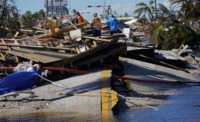Skanska is turning to cutting-edge hydration testing technology to keep workers safe in places like Miami, where job site temperatures routinely climb to dangerous levels.
The MX3 Hydration Testing System, from Austin, Texas-based MX3 Diagnostics, tests either saliva or sweat to show a worker’s hydration level and to recommend how, if needed, that worker can best rehydrate.
Daimon Perez, EHS director for Skanska’s Florida region, says ill effects from dehydration or heat stress can arise even before the potentially dehydrated workers begin to perceive them.
“With this equipment, we have an accurate result,” he says. “It’s very simple to use.”
In Florida, three devices are in the field, being used on a weekly basis to support the firm’s other efforts to beat the heat, he says, and to help workers correlate effects they’re feeling with hard data on their hydration levels.
MX3 Diagnostics primarily markets the device to athletes, though its website includes information on the Occupational Safety and Health Administration's National Emphasis Program as well as examples of it being implemented on construction sites and other workplaces.
Jarrett Milligan, senior safety director with Skanska, says the firm is always looking for new technologies to partner with, “to advance the sport.”
“We consider construction tradespeople to be professional athletes in our industry, and they are the top priority to us out in the field,” he says, noting that an ironworker climbing steel could be putting the same amount of stress or strain on their body as a professional golfer or baseball player.
According to MX3, the testing device uses a handheld electrochemical workstation capable of laboratory-grade analysis in real time. Results show up on a phone app, which can keep a profile for each worker and show their tracked hydration data over time. One device is able to cover an entire job site, Perez says. It’s a pilot project, but it’s been immediately successful, and feedback has been positive, he adds.
“I’ve already had meetings with our medical provider and said, ‘Hey, this piece of equipment, I think this is going to wind up becoming one of those standards,’” Milligan says.
The MX3 Hydration Testing System uses test strips to measure a worker’s hydration via either sweat or saliva. Including strips, the devices cost Skanska roughly $1,500 each. Perez says the effort supports Skanska’s broader efforts at keeping workers safe in the heat and helps employees identify when they are dehydrated.
On its website, MX3 explains the device can run two separate tests, one of saliva and one of sweat, to show how much and which type of fluid will best replenish lost electrolytes, to “test, track and hydrate effectively to optimize your performance and reduce injury.”
Broader Threat of Heat-related Illness and Injury
For Skanska, hydration testing goes above and beyond current regulations to keep workers safe in a warming climate, and a changing climate of regulations. Excessive heat can cause multiple health problems for workers on job sites, from exhaustion to heat stroke and death, injuries that proper precautions like shade, rest and water can largely prevent, as ENR reported in July with the news of a proposed new rule from OSHA.
In 2022, OSHA says 43 fatalities were due specifically to environmental heat, up from 36 in 2021. Between 2011 and 2022, OSHA reports 479 worker deaths from environmental heat, averaging 40 per year. Between 2011 and 2020, OSHA reports an estimated 33,890 work-related heat injuries, cautioning that those figures are likely “vast" underestimates of the true figure.
The new proposed rule would require employers to develop an injury and illness prevention plan to control heat hazards in areas affected by excessive heat, which it lists as higher than 80°. It includes requirements for drinking water, and other heat safety measures, with special attention to workers unaccustomed to the heat. Beyond reminding workers to drink water, it’s creating a culture of awareness around staying hydrated and safe in the heat.
“This is helping you start to educate yourself, and make sure you get properly hydrated,” says Perez. “It’s not just getting water in the moment.”
The safety program starts the day before, he explains, and with work starting at 6:30 a.m. to avoid the worst of the Miami sun, it’s also about avoiding an excess of caffeine via coffee or energy drinks in the morning. So far it’s gone over well with workers, he says.
“They know that Sunday night they need to be drinking water or Gatorade,” says Milligan, who has just begun deploying the device in Phoenix, where temperatures topped 100° for more than 100 consecutive days this year. In Phoenix, they’re also using flags to notify workers of heat risk. A red flag tells crews to be cautious, and a black flag means stop work.
“There’s no feeling on the job site that anybody is out there trying to be disciplinary around this, right? We’re looking out for you,” Milligan says. “We want to make sure that you can come to work and be the best you are at your trade, your task.”
The device is helping leaders guide conversations around heat safety across the board, too, incorporating other efforts like the flag system, cooling centers and even hydrating popsicles. Skanska also employs emergency medical technicians or physician assistants on nearly all projects, Perez says, and the MX3 provides them with a tool to help them manage workers’ health on a day-to-day basis as they walk job sites.
“We are expanding utilization in the near future, but the reception has been really good,” Perez says. “They see that we care. It’s basically our safety culture: care for life … we provide the right information so they can make the right decision.”




